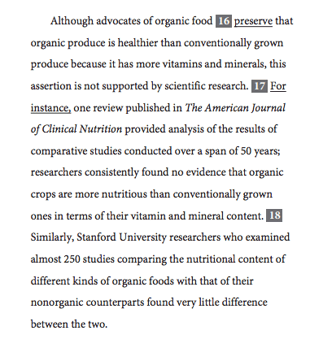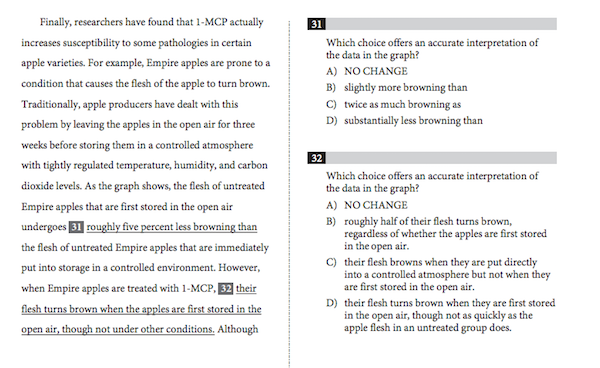How Many Passages In Sat Writing
"Writing, to me, is simply thinking through my fingers." If Isaac Asimov were talking about the SAT Writing and Language section, he would probably add that he would have to think through his fingers fast. With 35 minutes for 44 multiple choice questions, you have to work quickly and efficiently to achieve a high score. Let's go over the Writing and Language section in detail so you know exactly what to expect. The Writing and Language section is your second section on the SAT. Writing and Language, together with Reading, makes up your verbal score (aka, "Evidence-based Reading and Writing" score). This section is 35 minutes long and asks you 44 multiple choice questions. All of the questions are based on passages. In fact, there are four passages followed by 11 questions each. Thepassages are sourced from the areas of Careers, Social Studies, the Humanities, and Science: You won't get any prose; all of the passages will be nonfiction, explanatory, or argument-based. One or more will also be accompanied by a related graphic, like a chart, table, or graph. The thing you need to know about the Writing and Language passages is that they're full of problems. They will be riddled with errors in punctuation, word choice, sentence structure, and organization. The multiple choice questions will point to various parts of the passages and ask you if and how each part should be fixed. The Writing and Language section tests your editorial skills. Let's take a closer look at how it does this. Writing and Language asks you to read error-strewn passages and make them better. First, you have to recognize whether or not there is an error. If there is, then you have to choose the answer that would fix or improve the sentence, paragraph, or passage. To accomplish this task, you need to understand grammar rules and how to organize ideas and use transitional words and phrases. According to College Board, Writing and Language questions test four main skills area: Command of Evidence, Words in Context, Expression of Ideas, Standard English Conventions. A little over half of questions ask about the first three skills areas and have to do with the development and organization of ideas and effective language use. The other half of questions cover Standard English Conventions. These questions ask about sentence structure, usage, and punctuation. They tend to be more detail-oriented questions. Let's take a closer look at each of these skill areas and what they test, along with an official sample question in each. Command of Evidence questions tend to look at the big picture. They want you to improve the way a passage presents information or imparts meaning. You might need to add a supporting detail, introductory sentence, or conclusion to make a passage more impactful. These questions often ask you to include the reason for making a change (ie, your "evidence"). This sample question falls into the Command of Evidence category. It wants you to strengthen a passage and provide your reasoning behind choosing a particular answer. Picking up on context clues is very important! How else are you going to figure out that it was Professor Plum with the candlestick in the billiard room? Words in Context are more detail-oriented than Command of Evidence questions, as they point to a particular word. You might need to replace a word that doesn't make sense or choose one that works better in its particular context. None of the words will be particularly advanced, but they might be ones that are easily confused (e.g. the words "outperform, outweigh, and outdo") or that take on different meanings depending on context. As with many Writing questions, Words in Context questions will have the option of "No Change." Before thinking about how to replace the word, you have to decide whether or not there's a problem in the first place. Here's a typical example of a Words in Context question in SAT Writing and Language. As their category indicates, Expression of Ideas questions ask you to think about how ideas are expressed. You might rearrange the order of sentences to improve flow or strengthen an argument. You might also choose to delete a sentence completely. These are "big picture" questions that ask you to make revisions that would make the passage more impactful. The following is an example of an Expression of Ideas question on the SAT. Almost half of the SAT Writing questions fall into this Standard English Conventions category. Here's where your understanding of grammar and punctuation rules comes into play. These questions ask you to fix errors in sentences and clauses. You might edit for errors in verb tense, subject-verb agreement, pronoun use, parallel construction, commas, or apostrophes. The following example, for instance, asks you to distinguish between "there" and "their" and to make sure the phrase under consideration has proper subject-verb agreement. The second question tests comma rules. In addition to these four major skill areas in Writing and Language, Command of Evidence, Words in Context, Expression of Ideas, and Standard English Conventions, you'll also encounter another question type that calls for its own special prep. About 2% to 4% of questions will be about data interpretation. On the redesigned SAT, data is all around you. As you read above, one or more of the passages in Writing and Language will be accompanied by a graphic, like a chart, table, graph, or some other visual that communicates data. The graphic will be related to the passage in some way, but it might be described incorrectly. Questions could ask you to revise an incorrect representation of the data or to add a sentence based on data to strengthen an argument. Here's an example of a data interpretation question on Writing and Language. The data interpretation questions are the only ones of the Writing section where you might have to flip between pages to read the question and then consult the graph. As you can see in the samples, all of the other questions should line up directly with the part(s) of the passage to which they refer. Now that you have a sense of the skills and question types on this section, read on for some key study tips to prepare for SAT Writing and Language. Get out your red pen. College Board has just given you the job of Editor-in-Chief. The SAT Writing and Language section asks you to be an editor. It presents you with flawed passages, and your job is to make them better. You might improve a word, fix a punctuation mistake, rearrange ideas, or add sentences to improve flow. While some of your editorial skills are the cumulative result of years of reading and reading, how can you take specific steps to prepare yourself for the SAT Writing section? Read on for six study tips to help you achieve your target scores. Almost half of the questions on the Writing section ask you to fix an error in grammar, usage, or punctuation. While grammar rules aren't the only part of your SAT Writing prep, they are a big part. To prepare, you should make sure you understand the most commonly tested grammar rules, like subject-verb agreement, parallel structure, and simplifying wordiness. By knowing the rule, you can pick up on what a question is asking you. Then you can confidently locate the right answer, rather than simply relying on what sounds or looks right. Get a firm grasp of grammar and usage rules so you can master these question types on SAT Writing. The old SAT didn't ask about punctuation, but the redesigned test does. You may need to fix a comma, apostrophe, semicolon, colon, or period, perhaps combining phrases into one sentence or separating a run-on into two sentences. Make sure to review the most commonly tested punctuation rules and then test your understanding with official practice questions. Pair each rule with relevant practice questions to reinforce the concept. Then take practice tests where the questions are all mixed up in random order to make sure you can recall the relevant punctuation rule when you get tested on it. These questions are tricky if you don't know, for example, the right way to use a semicolon. If you do, though, then they're a piece of cake. As you read above, all of the passages on the Writing section ask about nonfiction, explanatory, or argument-based texts. If you've spent English classes only reading literature, likeThe Great Gatsby and The Crucible, then you might need extra practice with non-prose texts. Some great sources for practice are nonfiction essays and newspaper articles. Read with an analytical eye, perhaps circling transitional words and taking notes on the margins about how ideas are organized or how an author builds an argument. Deconstruct the text in front of you just as an editor would. If a passage strikes you as particularly strong, try to pick apart why it's so strong. If it fails to impress, note what you would change to make it more impactful. Developing your editorial eye is key for doing well on the SAT Writing and Language section, where your primary task is to edit and revise pieces of writing. Look alive! You need to stay alert to make it through the long winter of SAT prep. Do any of your teachers give you editorial feedback on your writing? If so, don't just go straight to the grade and ignore the marks and comments. The marks and comments are key to developing an understanding of edits and revisions. Study them closely, and ask questions if you don't understand any. Similarly, you might go out of your way to ask your English teacher, for example, to give you feedback on a piece of writing. Or you could become an editor yourself and trade comments with a peer. If you get feedback on your papers, pay close attention - it will help you become a better writer, which will, in turn, help you do better on the Writing section of the SAT! Some of the questions in SAT Writing fall into the Words in Context category. None of the highlighted terms are particularly obscure or advanced. Instead, they're relatively common words that may change meaning depending on context. Studying mid-level, multiple-meaning words will help you for both the Writing and Reading sections of the SAT. Beyond studying word lists, pay attention to how certain words shift depending on how they're being used. This understanding, along with the ability to pick up on context clues, will help you master Words in Context questions. Finally, you'll get a few questions asking you to interpret data from graphics. These questions require an understanding of the graphic, plus they might ask you to go one step further to fix a mistake or insert a description into the passage. You can hone this skill in your Science and History classes, with SAT practice questions, and even with ACT Science questions (though, of course, not all the Writing data interpretation questions will necessarily be related to Science). Make sure that you can grasp a variety of charts and graphs, like pie charts, line graphs, scatterplots, bar graphs, and tables. While data interpretation may not be the first thing that comes to mind when you think about a writing test, it needs to be part of your prep for SAT Writing and Language. By honing your editorial and data interpretation skills, along with learning exactly what's tested on this second section of the SAT, you'll be one step closer to your goals. In closing, let's review the key points that you need to know about the Writing and Language section of the SAT. SAT Writing is your second section on the SAT, and all the questions are multiple choice and passage-based. This section asks you to be an editor and to fix errors in grammar, punctuation, and organization. Your job, simply put, is to make a flawed piece of writing better. To prepare for this section, you should study rules of grammar, usage, and punctuation. Beyond these rules, you should read and write widely, keeping a critical eye on structure and flow, to hone your editorial skills. You might also practice peer editing with a friend, as well as pay close attention to any feedback you get on your own writing from teachers. The Writing and Language section makes up half your verbal score, while the first section of the SAT, Reading, makes up the other half. By learning all about the skills tested, question types, and study strategies, you're well on your way to achieving your target verbal scores. Is writing your strong subject, and you want the SAT score to prove it? This perfect scorer gives you 11 strategies for getting a perfect score. Feeling unsure about data interpretation questions? This guide tells you how to analyze graphics on the Writing and Reading sections of the SAT. Official SAT practice tests are the gold standard for high quality practice questions. Download 8 free printable official SAT tests here. Want to improve your SAT score by 160 points? Check out our best-in-class online SAT prep classes. We guarantee your money back if you don't improve your SAT score by 160 points or more. Our classes are entirely online, and they're taught by SAT experts. If you liked this article, you'll love our classes. Along with expert-led classes, you'll get personalized homework with thousands of practice problems organized by individual skills so you learn most effectively. We'll also give you a step-by-step, custom program to follow so you'll never be confused about what to study next. Try it risk-free today: 
Format of the SAT Writing
Writing and Language: Testing Your Editorial Skills
1. Command of Evidence



2. Words in Context

3. Expression of Ideas


4. Standard English Conventions


Extra Question Type: Data Interpretation



How to Study for SAT Writing and Language
1. Study Grammar Rules
2. Study Punctuation Rules
3. Read Essays and Newspaper Articles

4. Pay Attention to Feedback on Your Writing
5. Study Multiple-Meaning Words
6. Practice Interpretating Data from Graphics
SAT Writing and Language: Key Points
What's Next?


About the Author
Rebecca graduated with her Master's in Adolescent Counseling from the Harvard Graduate School of Education. She has years of teaching and college counseling experience and is passionate about helping students achieve their goals and improve their well-being. She graduated magna cum laude from Tufts University and scored in the 99th percentile on the SAT.
How Many Passages In Sat Writing
Source: https://blog.prepscholar.com/whats-actually-tested-on-sat-writing-grammar-and-questions
Posted by: jonesbobjections.blogspot.com

0 Response to "How Many Passages In Sat Writing"
Post a Comment